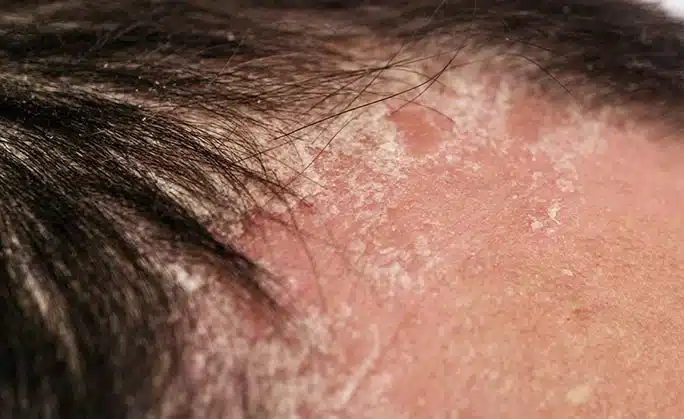Introduction
In a recent publication in Frontiers in Immunology, researchers have undertaken a comprehensive multi-omics investigation to shed light on potential breakthroughs in the treatment of psoriasis. Employing cutting-edge techniques, including single-cell transcriptomics (scRNA-seq), microarray analysis, and immunohistochemistry, they aimed to unravel the translational impact of anti-interleukin-17A (IL-17A) therapy in alleviating autoimmune dysfunctions associated with type 17 T-cells (T17), with the ultimate goal of effectively addressing human psoriasis.
Understanding Psoriasis
Psoriasis, an autoimmune skin condition characterized by scaly and itchy rashes, predominantly affecting the scalp, trunk, elbows, and knees, has proven to be a challenging and lifelong ailment. While topical treatments have offered symptomatic relief for milder cases, a definitive cure for this condition remains elusive.
With an estimated prevalence of over 3.2% of the global population, psoriasis is one of the most common autoimmune disorders. Though not directly life-threatening, it comes with significant comorbidities, including metabolic irregularities, psoriatic arthritis, vascular inflammation, diabetes, and cardiovascular diseases. These comorbidities have been shown to reduce patients’ life expectancy by 3-5 years or even more.
Read Guide about Wegovy Dosage Guide: The Best Way For Weight Loss
Recent research has hinted at the potential of biologics targeting interleukin-23 (IL-23) to suppress T17 cells, responsible for autoimmune responses. Some studies have suggested that these treatments may lead to lasting improvements in psoriasis even after discontinuation. However, the exact transcriptomic mechanisms underpinning the systemic blockade of the IL-23/T17 axis and the resulting immune tolerance have remained poorly understood.
Tip: Please fill out this form to determine whether or not you or a friend are eligible for a CGM and, Also learn about Glucose Variability
Given the prevalence and life-threatening implications of psoriasis-related comorbidities, deciphering the role of the IL-23/T17 axis holds the key to developing innovative drugs and therapies that could offer the first-ever cure for this condition.
About the Study
The researchers in this study aimed to provide translational evidence that blocking interleukin-17A (IL-17A), a related interleukin, could potentially modify the regulatory transcriptome of skin immune cells, thereby reversing the effects of psoriasis. Their research utilized immune cell-enriched single-cell RNA sequencing (scRNA-seq), microarray analysis, and immunohistochemistry to assess the impact of IL-17A blockade on psoriatic lesions before and after treatment.
The study involved 23 adult psoriasis patients who received secukinumab, an anti-IL-17A monoclonal antibody, following a phase II clinical trial protocol. Participants received secukinumab injections for at least 12 weeks. Psoriasis skin biopsy samples were collected during the trial, along with relevant patient data. The samples were analyzed using various techniques, including scRNA-seq, microarray analysis, and immunohistochemistry.
Study Findings
Immunohistochemistry staining revealed that a 12-week secukinumab treatment reduced T-cell and dendritic cell (DC) signatures while showing evidence of keratinocyte (KC) hyperproliferation. This systematic blockade of IL-17A led to increased expression of genes regulating molecular expression in excised lesions post-treatment. These findings aligned with single-cell cluster analysis, which demonstrated reduced T17 cell signatures.
Further examination of DC cell signatures at the single-cell cluster level indicated that IL-23A expression in both semi-mature and mature DCs decreased after secukinumab treatment. Immunohistochemistry results demonstrated a reduction in the absolute population numbers of both mature and semi-mature DCs. Notably, there was an upregulation of regulatory transcriptome expression in semi-mature DCs, including increased expression levels of CD1C and CD14 genes, responsible for suppressing antigen-specific T-cell responses.
Must Read About: NO-Ferroheme as a Key Signaling Entity in the Vasculature
Conclusion
This study employed state-of-the-art multi-omics approaches to unveil the differential gene expressions and potential molecular mechanisms behind the effectiveness of anti-IL treatments in addressing the challenging issue of psoriasis. Their findings from a phase II trial involving secukinumab treatment on adult psoriasis patients demonstrated significant reductions in autoimmune responses mediated by T-cells, DCs, and KCs. Importantly, these positive effects persisted even after the cessation of treatment, offering promise for future drugs that may finally provide a cure for this common and chronic condition. While further extensive clinical trials are required, this research marks a promising step in the quest to combat this potentially life-threatening disease.


